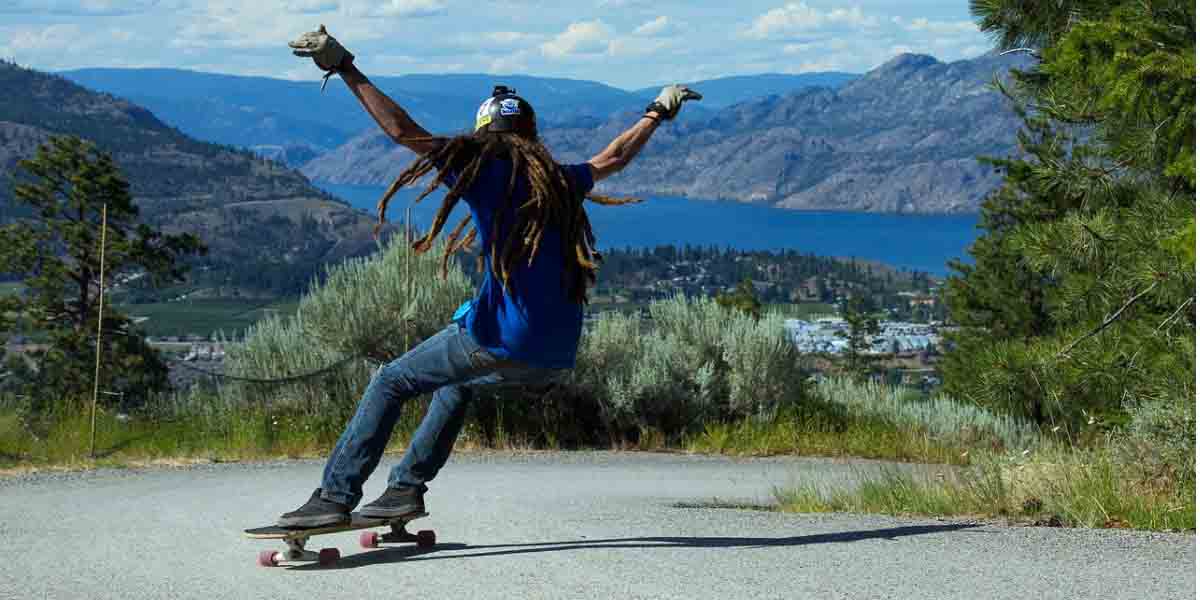When you first lay eyes on a skateboard and a longboard, it’s like meeting two siblings. Who look alike but have their own special styles. At a glance, they seem similar, but when you look closer, it reveals they’re not the same. Similarly, skateboards and longboards also have differences. Sometimes people start debates about “skateboard vs longboard.”
These are two types of boards with wheels. Skateboards are small and do beautiful tricks at the skate park. Longboards are bigger and go for smooth rides on the streets—some like flips, and some like cruising.
Before buying, you need to know about: “What is the difference between a longboard and a skateboard? And which is best for you?” In the upcoming content, we’ll delve into the differences between them. After reading this article, you can decide which one suits you best. So, let’s jump into the article.
The Short History of Longboards And Skateboards
Let’s dive into the story of skateboards and longboards! In the 1950s, Californian and Hawaiian surfers craved the thrill of waves even when the ocean was flat. So, they took to the streets, carving up sidewalks on planks fitted with roller skate wheels. This is the original “proto-skateboard.“
Soon, companies like Makaha, Jack’s, and Hobie started making real skateboards. The 1960s and 1970s were the golden era. Skateboarding exploded with freestyle tricks and pool riding. The boards got shorter and more agile, with kicktails and noses.

Now, longboards have a different story. Back in the 50s in Oahu, surfers turned their boards into landlocked wave riders, giving birth to “sidewalk surfing.” The Makaha 33″ Commander was a key player, having longer decks and bigger wheels than regular skateboards. Larry Stevenson of Makaha made a game-changer in 1970—the first true “skate” with both a kicktail and a nose, blurring the lines between two styles.
In the 70s and 80s, longboard popularity took a backseat to freestyle and street skating. But dedicated riders kept it alive, perfecting downhill and carving techniques.
The 90s and 2000s brought a tidal wave of revival. Companies like Sector 9 pushed design limits, promoting downhill racing and chill cruising. Longboarding got even cooler with dancing, carving, and commuting—proving it’s not just about catching waves on concrete.
Nowadays, longboards and skateboards have their own cool styles. Skateboarding is all about doing tricky moves and getting really good at them. On the other side, longboarding is about smooth rides, making cool turns, and going down hills like a boss.
Difference Between A Skateboard And A Longboard
Skateboards and longboards are used for skating. But they have some key differences in terms of design, purpose, and use. The main differences are in
- The shape, size, and flexibility of decks
- The diameter and materials of the wheels
- Width measurements and stability of trucks
- Riding style of skaters
Let’s have a breakdown of some of the main differences.
The Shape And Size: Longboard Skateboard Dimensions
Skateboards: Generally, skateboards are shorter and narrower than longboards. It measures around 28–34 inches long and 7–10 inches wide. Skateboards have a curved nose and tails, which make them easier to ollie and flip for tricks. They have a thinner deck. If you want to learn new skating tricks, then you must primarily choose a thinner board.
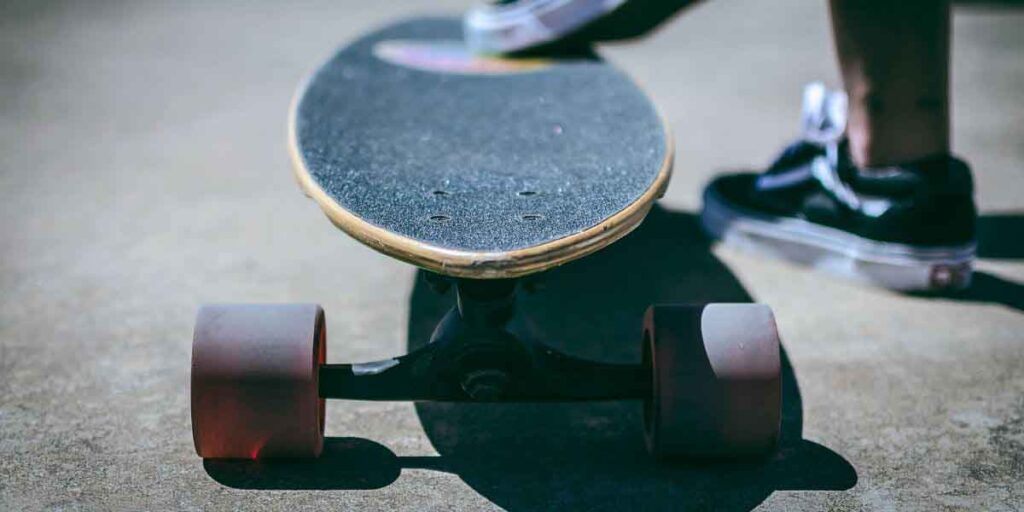
Longboards: These boards are bigger than skateboards. It is around 35–60 inches in length and 9–10 inches wide. They have a thicker deck with a nose and tail, making them more comfortable for cruising and downhill riding. The deck may have different types of shapes, such as pintail, drop-through, or cruiser shapes.
Wheels
Skateboards have smaller and harder wheels. Typically around 52–56 mm in diameter and made of a harder urethane compound. It makes them more responsive and easier to control when performing technical maneuvers.
Longboards have large, soft wheels. Usually around 60–75 mm in diameter, they are made of a softer urethane compound. As a result, these wheels make your ride smoother and more comfortable.
Trucks
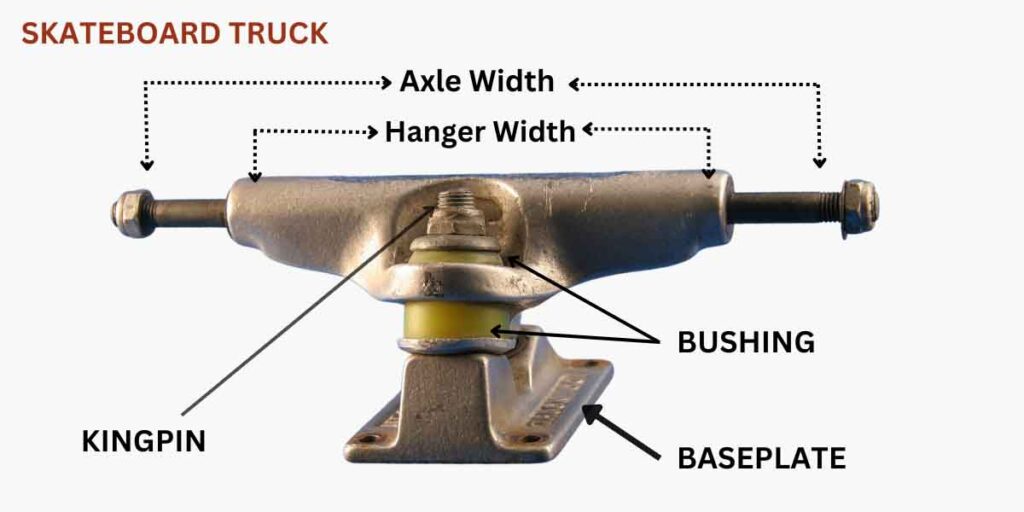
Skateboards have narrower trucks. In this case, they also use a traditional kingpin (TKP). Usually, it measures around 139–149 mm wide, which allows for better carves and turns.
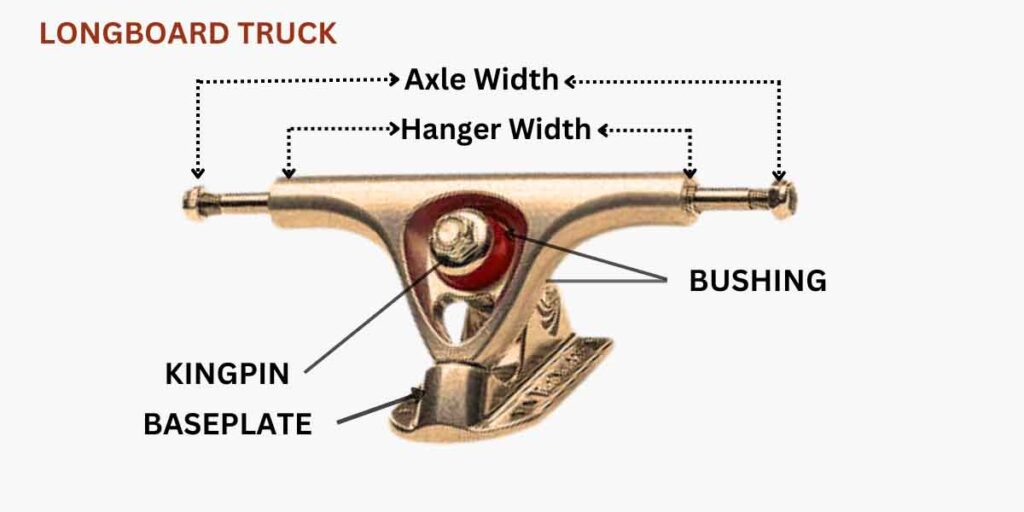
Longboards have wider trucks, which are around 150–180 millimeters wide. And these provide more stability and control at higher speeds. Usually, they have a reverse kingpin (RKP). Longboard trucks are more flexible than any other board. This is the main reason for a comfortable and smooth ride.
Riding Style
Skateboards are designed for street skating, doing tricks, and grinding on rails and ledges.
On the other side, longboards are more versatile and can be used for cruising, commuting, carving, dancing, downhill racing, and many more.
Some riders asked, Which is the best choice for me? Basically, it will depend on your riding style and preferences. If you’re a beginner, a longboard might be a better option first. When you are good at longboarding, then you can try skateboarding.
Can You Use A Skateboard As A Longboard?
Yes, you can ride a skateboard as a longboard for casual cruising on smooth ground. But if you plan on riding for a long distance at higher speeds, then you should choose a longboard.
Another option is that you can modify your skateboard with larger wheels and wider trucks to make it more like a longboard. However, this can still create some limitations due to the differences in design.
Is Longboarding Easier Than Skateboarding?

Yes, longboarding can be easier to learn than skateboarding for some people. They are bigger and more stable, so it’s easier to balance. If you just want to ride outdoors without doing fancy tricks, longboarding might be a simpler and more comfy choice.
Skateboarding is a little bit trickier at first. Skateboards are smaller, so keeping your balance takes more practice. Learning cool tricks and maneuvers can be harder too. If you want a smoother start, longboarding might be easier, but it depends on what you like to do.
Can Longboards Do Tricks?
Yes, absolutely! Longboards are capable of doing some tricks. The tricks range from simple footwork maneuvers to impressive flips and grabs. Some tricks might be slightly easier on skateboards because of their small size and lighter weight. They also offer their own advantages and tricks. Here are some examples of tricks you can do on a longboard:
Beginner Tricks:
- Ghostride
- Pivot/Shove
- No-comply 180
- Hippy jump
Intermediate Tricks:
- Peter Pan
- Ollie
- Drop-in
Advanced Tricks:
- Kickflip
- Pop shove-it
- Grab tricks
Remember, you must wear protective gear before learning any tricks. Start with the basics and progress gradually.
The Pros And Cons of Skateboard Vs Longboard
Both of the boards have some pros and cons. We will discuss it here. Here are some basic pros and cons of longboarding vs skateboarding:
Skateboard Pros
- Highly-Maneuverability: Skateboards are best for technical maneuvers and tricks.
- Versatility: Skateboards are designed for different kinds of riding styles, such as street, park, and freestyle, allowing for a wide range of tricks.
- Portability: The smaller size and lighter weight make skateboards more portable and easier to carry and stash in backpacks or bags.
- Trick-focused: Skateboards are preferred by riders who want to focus on tricks like flips, ollies, and other technical moves.
- Relatively Affordable: Generally, the cost of skateboards is cheaper than longboards because of their simple materials and construction.
Skateboard Cons
- Stability: The smaller size and shorter wheels of skateboards can make them less stable for beginners, especially at higher speeds.
- Comfort: Skateboards are less comfortable for long rides and also less ideal for cruising.
- Learning Curve: Balancing and mastering basic skills can be more challenging for beginners.
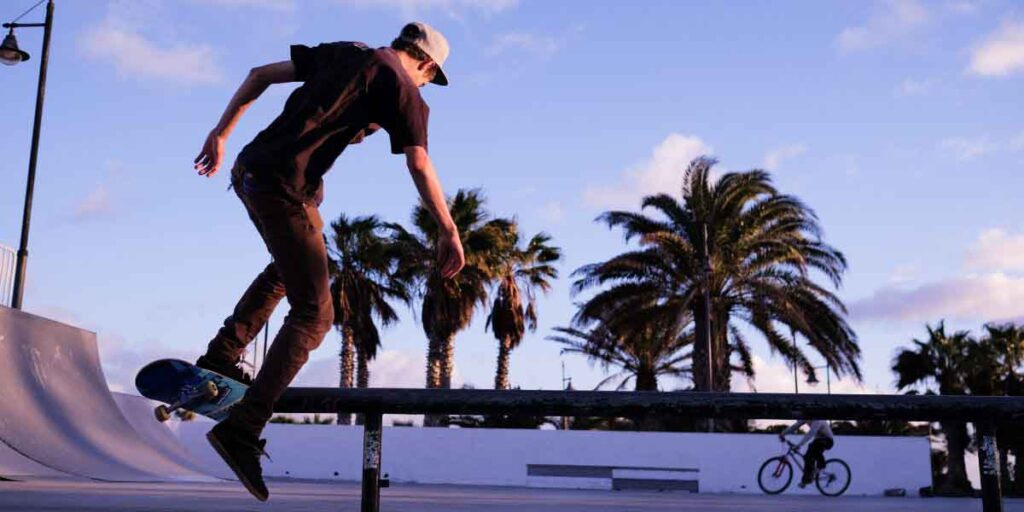
Longboard Pros
- Smooth & Stable: Large, soft wheels and wider decks offer a comfortable, stable ride over rough surfaces.
- Cruising & Transportation: Ideal for long distances and commuting thanks to effortless pushing and sustained speed.
- Beginner-Friendly: They are easier to balance and learn on compared to skateboards, making them a good starting point.
- Variety of Styles: Longboards come in various shapes and setups, catering to diverse riding styles like downhill, carving, dancing, and pumping.
Longboard Cons
- Less Maneuverable: Generally, longboards are less maneuverable than skateboards.
- Less Trick-Oriented: While capable of some tricks, they are not as versatile as skateboards.
- Hard to Carry: not as portable as skateboards due to their large size.
- Higher Cost: Generally, more expensive than skateboards due to their larger decks and specialized components.
How Do I Choose Between A Longboard vs Skateboard?
It depends on your goal and purpose. You need to know which one you need first. I’ll try to give some quick answers here so that you can decide easily.
Think about your target:
- Cruising & commuting: Go for a longboard.
- Learning to skate & tricks: Choose a skateboard.
- Enjoy both, but prioritize long distances & comfort: Consider a cruiser skateboard.
Factor in your experience:
- Beginner: Go for longboards. Because they are easier to balance.
- Intermediate/Advanced: If you already have some balance and skating skills experience, you might find the challenging and trick-focused nature of a skateboard. So, you can choose a skateboard.
Conclusion
In the battle of skateboard vs longboard, we’ve laid out the facts for you. We’ve also unpacked the pros and cons to help guide your decision.
Ultimately, the best way to choose is to try both boards! If possible, borrow a friend’s board or visit a skate shop to feel them out. Remember, there’s no right or wrong answer—just go with what brings you the most joy on wheels! Life’s an adventure on wheels, so roll on with a smile.

